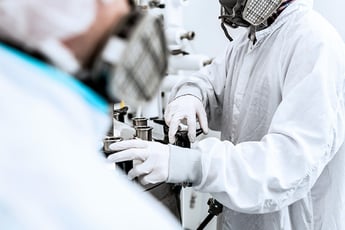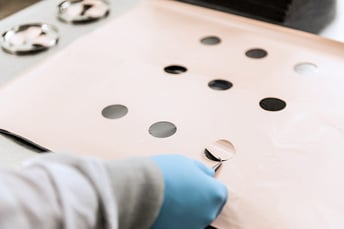Transdermal patches are an innovative and painless method of drug delivery. These patches stick to the skin and contain a predetermined amount of active medication that’s absorbed into the bloodstream through the dermal layer (the second and thickest of our three layers of skin). There are a variety of transdermal patches, including active, passive, iontophoresis, matrix, reservoir, island, and sophisticated multi-material patches. All of these patches are variations of the same theme—a layered laminated adhesive composed of a backing, the active drug, and a release liner.
While every patch is created similarly, there are a lot of factors that must be considered for each type. Let's explore the process in more detail.
Following A FOUR-STEP PROCESS
Step 1: Mix the ingredients together
 When working from a developed formula, the first step of the manufacturing process is to create a consistent mixture of all the “ingredients” in a large vessel.
When working from a developed formula, the first step of the manufacturing process is to create a consistent mixture of all the “ingredients” in a large vessel.
The active pharmaceutical formula is mixed together with excipients (inactive substances) to form a batch of a liquid adhesive matrix.
Our manufacturing process relies on absolute precision when it comes to ingredients, viscosity, temperature, pH, and time. These variables are all meticulously tracked in order to achieve the optimum state of uniformity. Depending on the medication, the active drug substance may be mixed separately from the adhesive material and sealed together in the following step.
Step 2: Coat and dry the mixture
With tablets and traditional pills, the coating step normally adds flavor, color, and/or durability. But because transdermal patches are applied to the skin, transdermal patch manufacturers use the coating step to apply the mixture to a polymer release liner.
That adhesive matrix we mixed together in step one is applied evenly to a substrate that will protect the adhesive and drug formulation. The liner is then removed before application to the skin.
Our coating machines carefully meter the mixture onto the release liner and can be programmed to meet any substance requirement. Tapemark’s machines can coat liners at widths from 3 –22 inches. We work with formulas at temperatures ranging from 100–350 degrees Fahrenheit and have the capacity to churn out liners at a speedy 65 feet per minute.
This coated liner then passes through state-of-the-art drying channels, which dry the entire matrix at specific predetermined speeds, temperatures, airflows, and humidity levels.
Step 3: Seal the laminatE
Immediately after drying is complete, the entire laminated material is sealed with an impermeable backing film. In this step, the active pharmaceutical ingredient that was mixed with the adhesive substance is formed together with a protective backing material. The backing seals the entire matrix together, essentially creating a single, enormous transdermal patch.
Note that for some types of transdermal patches, there are extra layers that are added before the laminate is fully sealed. These may be rate-controlling membranes, drug reservoirs, or monitoring devices.
Step 4: Convert to size and pouch the patches.
 The final step is to cut the patches down to the appropriate size and shape. This is done by slicing the bulk product into narrower rolls of laminate, and then sending these through a die-cutting machine to achieve the final shape of the patch. The shape of your patch is ultimately decided by what will maximize effectiveness and comfort for patients.
The final step is to cut the patches down to the appropriate size and shape. This is done by slicing the bulk product into narrower rolls of laminate, and then sending these through a die-cutting machine to achieve the final shape of the patch. The shape of your patch is ultimately decided by what will maximize effectiveness and comfort for patients.
Once the final patches are converted into individual units, they are ready to be heat-sealed into their pouches for shipment.
As a CDMO, we can help.
Every step for manufacturing transdermal patches is equally important. Without consistency, precision, and speed throughout, your product will not meet the high-quality standards you expect.
At Tapemark, we utilize built-in quality control features, as well as routine safety and quality checks to ensure the integrity and consistency of each patch. We follow the highest quality manufacturing standards so that your patches will always provide consistent transdermal diffusion to your patients. And because we have experience manufacturing transdermal patches, we offer unique insights to help your product come out successful.
Talk with our team to learn how our state-of-the-art manufacturing equipment, customizable services, and experience can help you produce your next transdermal patch.
